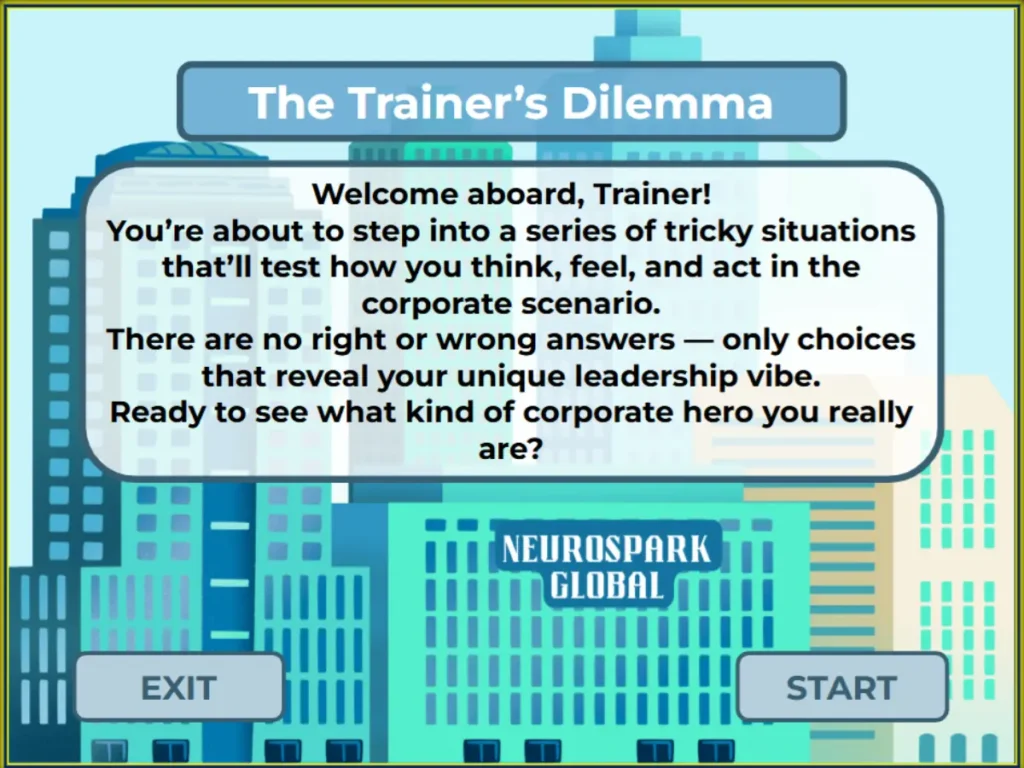Featured project
The Trainer’s Dilemma — Detailed Project Presentation Framework
This project started with a question I’ve often faced: what happens when you’re asked to fix a course — but the real problems lie beneath the surface? This scenario was born from a common real-world challenge: redesigning a course with limited direction and lots of moving parts.
On this page, I’m sharing the full journey:
- The problem that inspired this scenario
- How I mapped out the story and built it in Storyline
- A peek into my process — with videos, visuals, and tools I used
- And of course, a glimpse of the final experience
Problem
Instructional designers tasked with rebuilding or fixing existing courses often face complex and ambiguous decisions that go far beyond instructional design alone. Depending on individual experience and unique workplace constraints, each designer navigates different challenges—from content gaps to stakeholder demands and technical limitations.“The Trainer’s Dilemma” simulates this complexity and ambiguity, providing a realistic scenario where designers must make critical decisions to rebuild a course effectively within real-world constraints
Process
I followed a modified ADDIE approach, tailored to a portfolio simulation that reflects real-world instructional design challenges.
Tools used: Articulate Storyline, Canva, PowerPoint (storyboarding), Pixabay, ChatGPT
1. Analysis
The project began by identifying a common challenge many instructional designers face: being asked to fix or rebuild a previously designed course without clear direction. These situations often involve navigating stakeholder dynamics, unclear expectations, and practical constraints — all of which inspired the scenario structure.
2. Design
I storyboarded a branching scenario to mirror how different instructional designers might approach these dilemmas. Learners can choose between two characters — a male and a female ID — to personalize their experience.
The scenario follows a Choice–Scenario–Consequence (CSC) model to reflect the complexity of real-world decision-making. Each key moment offers choices that lead to different narrative branches and outcomes, encouraging reflection on how small decisions can shape the success or failure of a redesign project.
The flow was intentionally designed to feel realistic, emphasizing authenticity, ambiguity, and practical consequences over “right” answers.
3. Development
Visual assets were created using Canva and PowerPoint, while background audio was sourced from Pixabay to enhance immersion.
In Articulate Storyline, I:
- Structured the branching paths and scene transitions
- Assigned behind-the-scenes variables and point values to track learner choices
- Used conditional logic to determine outcomes based on the decisions made — all without showing scores explicitly, keeping the focus on narrative and reflection
4. Implementation
As a portfolio piece, the implementation was limited to peer and mentor review. I simulated a soft launch by sharing the module in design communities and testing the experience internally.
5. Evaluation
I conducted informal formative evaluation by collecting peer feedback on the clarity of the scenario, decision impact, and narrative flow. This helped fine-tune the branching logic and polish the learner experience.

